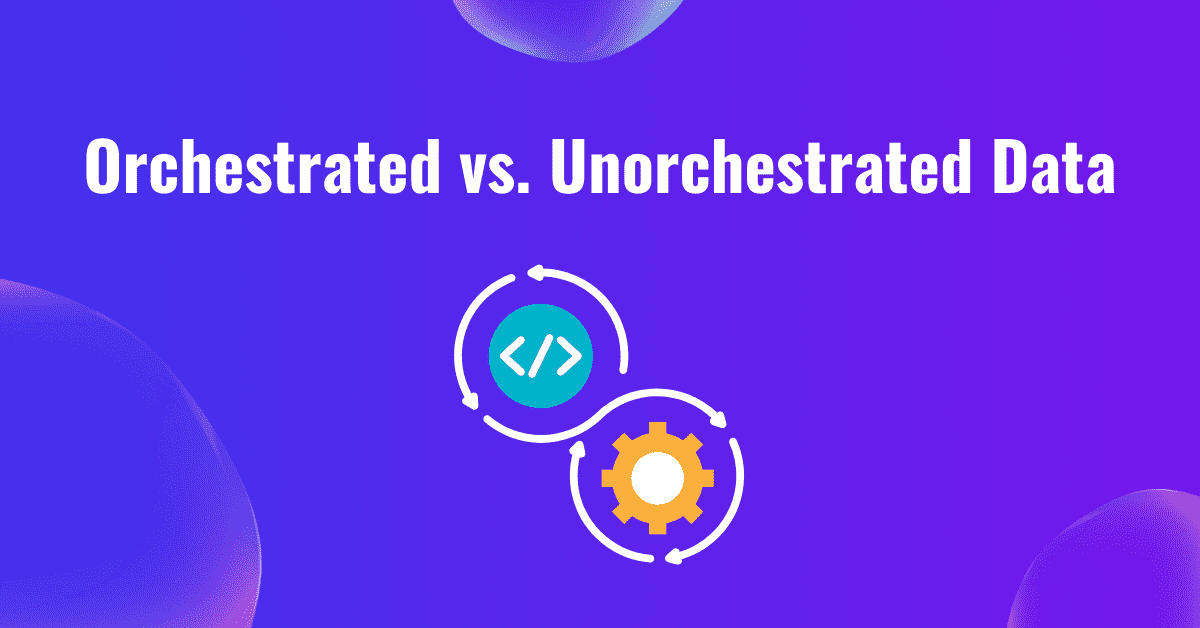In today’s data-driven world, data is the lifeblood of businesses. As organizations strive to extract maximum value from their data, the concept of “data orchestration” has emerged as a critical tool.
Data orchestration is the process of automating and streamlining data flows between various systems and applications. It involves coordinating data ingestion, transformation, and delivery to ensure data consistency, reliability, and accessibility.
Understanding the fundamentals of data orchestration, the difference between orchestrated and unorchestrated data, and the benefits of data orchestration is crucial in navigating the complex world of data management.
What is Data Orchestration?

Data orchestration, in practical terms, means bringing together different tools and techniques to simplify and automate data management, leading to improved analytics and insights.
In other words, data orchestration is a streamlined way of managing complex data flows between systems. It collects fractured data sources and makes diverse formats uniform and cohesive in a single entity.
Therefore, it enables better analytics with reduced redundant queries and redundant data. It eventually brings out one dependable data stream that organizations can use to generate business insights.
Orchestrated vs. Unorchestrated Data
To understand the difference between orchestrated and unorchestrated data, consider a manufacturing plant:
- Orchestrated Data: Imagine a well-oiled machine where every step in the manufacturing process is automated, controlled, and monitored. This is analogous to orchestrated data. It’s managed, organized, and controlled by a central system, ensuring smooth data flows and easy accessibility.
- Unorchestrated Data: Now, picture a less organized scenario where raw materials are scattered around the factory floor, and workers manually move them from one station to another. This is similar to unorchestrated data. It’s not actively managed or coordinated, making it more difficult to track, analyze, and utilize.
Modern data sources generate diverse formats of semi-structured and unstructured information. Historically, teams had to manually process, validate, and store this data to extract value from it.
Unlike traditional methods that create data silos, orchestrated data provides a single, standardized interface that any client application can access programmatically.
Orchestrated Data | Unorchestrated Data |
|---|---|
Orchestrated data is actively managed, organized, and controlled by a central system or process. | Unorchestrated data is not actively managed or coordinated by a central system. |
The data flow and processing are coordinated and automated, often through tools or platforms like data pipelines, ETL (Extract, Transform, Load) processes, or
data orchestration platforms. | This data may come from various sources, such as user-generated content, IoT devices, or external APIs, and may not have a clear structure or processing workflow. |
Orchestrated data is typically more structured, reliable, and easier to monitor and analyze, as the data management process is well-defined and controlled. | Unorchestrated data can be more challenging to manage, as it may be scattered across different systems or formats, and the data flow and processing are not centrally controlled. |
Relation to Data Management and Observability
Data orchestration is essential to data management and is closely related to observability. Observability platforms can ingest, normalize, correlate, and visualize both orchestrated and unorchestrated data. They can help identify anomalies, troubleshoot issues, and optimize performance.
Data management practices, such as data governance, quality control, and lineage, are more easily applied to orchestrated data, as the data flow and processing are more transparent and controllable.
Here’s how an observability platform handles orchestrated and unorchestrated data:
- Data Ingestion:
- Observability platforms are designed to ingest data from various sources, including unstructured or semi-structured data sources like logs, metrics, traces, and events.
- They often provide flexible ingestion mechanisms, such as APIs, agents, or integrations, to accommodate various data formats and sources, including unorchestrated data.
- Data Normalization:
- Observability platforms typically include capabilities to normalize and structure unorchestrated data, making it more amenable to analysis and visualization.
- This may involve parsing, enriching, and transforming the data to fit a standard schema or data model used by the observability platform.
- Correlation and Contextualization:
- Observability platforms can correlate unorchestrated data from different sources, such as logs, metrics, and traces, to provide a more comprehensive understanding of the system’s behavior and performance.
- They may also enrich the unorchestrated data with additional context, such as metadata, tags, or relationships, to enable more meaningful analysis and troubleshooting.
- Visualization and Exploration:
- Observability platforms often provide intuitive dashboards and visualization tools that can handle both orchestrated and unorchestrated data, allowing users to explore, analyze, and gain insights from the data.
- This can include features like ad-hoc querying, custom visualizations, and the ability to drill down into the underlying data.
- Alerting and Anomaly Detection:
- Observability platforms can leverage unorchestrated data to detect anomalies, patterns, and trends and trigger alerts based on predefined rules or machine learning models.
- This can help identify issues or potential problems in complex, distributed systems that generate unstructured or unorchestrated data.
Benefits of Data Orchestration
Data orchestration connects disparate storage systems, eliminating data silos without requiring extensive migrations. It offers numerous advantages, including these:
- Improved Data Quality: By automating data flows and enforcing data quality standards, orchestration helps ensure data accuracy and consistency.
- Enhanced Data Accessibility: Orchestrated data is easily accessible to various stakeholders, enabling better decision-making and collaboration.
- Increased Efficiency: Automation reduces manual effort, speeds up data processing, and minimizes errors.
- Cost Reduction: By streamlining data workflows and eliminating redundant tasks, orchestration can lead to significant cost savings.
- Enhanced Security: Orchestration can help improve data security by implementing robust access controls and monitoring data flows.
Technical Advantages for Enterprises:
- Maintains consistent SLAs through real-time data validation and automated monitoring
- Improves performance by making data locally accessible through a unified namespace, reducing I/O bottlenecks
- Enforces consistent data governance across distributed teams
- Protects data quality by quarantining corrupt data sources
- Enables flexible scaling of data pipelines independent of storage/compute resources
- Supports platform-agnostic frameworks via API integration
Business Impact:
- Provides real-time data analysis for faster decision-making
- Reduces infrastructure costs through pay-per-use model
- Enables cross-departmental collaboration through shared access to data pipelines
- Leverages cloud computing benefits (flexible storage, scalability, high availability)
- Supports self-service data infrastructure across business units
Data orchestration is a powerful tool that can help organizations harness the full potential of their data. By understanding the difference between orchestrated and unorchestrated data, businesses can make informed decisions about their data management strategies and achieve better outcomes.
To learn more about how Apica can enhance your data management, book a demo or talk to our technical team.










